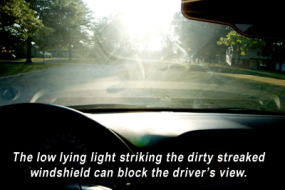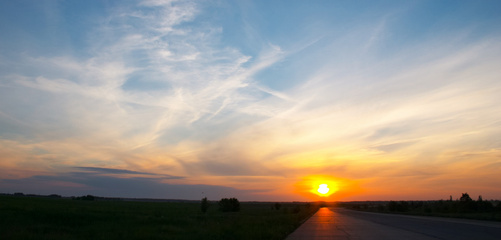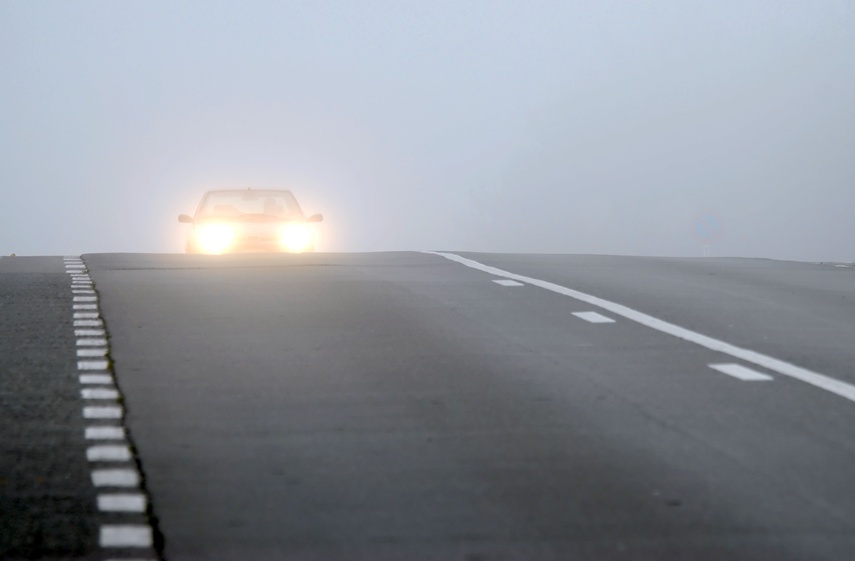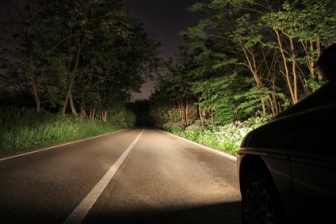Glare from Light - Vehicle Interaction
Glare from the dashboard: Sunlight reflecting off a dashboard may create a veiling glare that disrupts the patient’s vision. During training driving rehabilitation specialists may place a dark matte across the dashboard to further reduced reflective glare. Proper selection of an automobile for a bioptic driver should include looking at  the potential of glare from the hood and dashboard. Fortunately, today most dashboards have matte finishes.
the potential of glare from the hood and dashboard. Fortunately, today most dashboards have matte finishes.
Windshield Glare: As glare strikes the windshield, dirt and streaks may scatter light causing a dangerous dense disability glare. Regularly cleaning the windshield and replacing worn wiper blades may reduce these issues.
The Glare of Low Lying Sun and Bioptic Driving
 Low Sun Glare: Driving into low-lying sunlight may create a dense disability glare that can temporarily blind the driver. Sunglasses and use of the visor may be helpful. Patients with corneal and cataract opacities are particularly susceptible to this glare. In some low vision patients such as those with macular degeneration or Histoplasmosis, the severe disability glare may be further amplified by poor glare recovery. Turning from a north south path towards low-lying sun may suddenly create a debilitating glare. Anticipating the roadway and sun postion and thus the potential problem in turning into the sun can help bioptic drivers. Likewise the effect of turning from a very bright path onto a dimmer tree lined street must be anticipated. Some patients will be advised to avoid driving into low lying sun in the morning or evening.
Low Sun Glare: Driving into low-lying sunlight may create a dense disability glare that can temporarily blind the driver. Sunglasses and use of the visor may be helpful. Patients with corneal and cataract opacities are particularly susceptible to this glare. In some low vision patients such as those with macular degeneration or Histoplasmosis, the severe disability glare may be further amplified by poor glare recovery. Turning from a north south path towards low-lying sun may suddenly create a debilitating glare. Anticipating the roadway and sun postion and thus the potential problem in turning into the sun can help bioptic drivers. Likewise the effect of turning from a very bright path onto a dimmer tree lined street must be anticipated. Some patients will be advised to avoid driving into low lying sun in the morning or evening.
Night Driving Issues and Bioptic Driving
Headlight Glare: Headlight glare at night causes a brief dazzling glare, but in some patients with poor glare recovery  repeated exposure to the bright headlights may cause temporary reduced vision. Sunglasses should not be worn at night. Proper techniques of looking at the side of the road to avoid the oncoming light should be used. Some patients feel yellow filters aid them at night, but any filter can reduce light available to the driver. The use of filters at night should be reviewed with your doctor.
repeated exposure to the bright headlights may cause temporary reduced vision. Sunglasses should not be worn at night. Proper techniques of looking at the side of the road to avoid the oncoming light should be used. Some patients feel yellow filters aid them at night, but any filter can reduce light available to the driver. The use of filters at night should be reviewed with your doctor.
Bioptic drivers requesting night driving privileges in Indiana must have an initial recommendation by the doctor followed by a night driving evaluated by the driving rehabilitation special. These recommendations are forwarded to the Indiana BMV, which makes the final determination. It can be obtained during the initial licensing, but in some cases it is deferred until the driver has more experience with bioptics. Night licensure varies by state.
Some bioptic drivers with mild visual field impairments that are adequate to pass for daytime driving may not be as safe for night driving. This group might include bioptic drivers after laser treatment for diabetic retinopathy and some macular degeneration patients. Each case must be looked at individually.
Some bioptic drivers actually function better at night. The most common examples are patients with Achromatopsia or other Cone Dystrophies.These patients lack adequate cone cells for bright light vision, but do have adequate rod cells for night vision. In bright light, they use special filtered contact lenses and sunglasses, but remove them for night vision.
<< Part 1 - Part 2 - Part 3 >>
